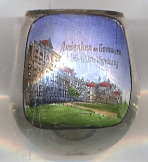

|
| DEUTSCHLAND | GERMANY |
| Bundesland: Sachsen-Anhalt | Saxony-Anhalt |
| Landkreis: Jerichower Land |
Gommern is situated at an elevation of 54 m on the river Ehle, a tributary of the river Elbe, about 16 km southeast of Magdeburg in Germany's state of Saxony-Anhalt. The municipality has a population of about 10,800 (2012).
The oldest known written document mentioning Guntmiri, a deed of donation from the bishopric of
Brandenburg, dates from AD 948. In 965, Emperor Otto I donated the place to the monastery
of Magdeburg. In the 12th century it came in possession of the duchy of Saxony and thus formed
an enclave within the Magdeburg and Brandenburg territories; however, it was pawned off to the archbishopric of Magdeburg
between 1283 and 1308 and to the city of Magdeburg between 1418 and 1539. In the 16th century, the Gommern district
became part of the Saxon administrative district of Belzig. The Renaissance château was built by Elector August of
Saxony in 1578. Gommern obtained the privileges of a market town in 1666 and in 1808 it became part of the Napoleonic
Kingdom of Westphalia and thus was the only French territory east of the river Elbe. However, already in 1813 it became part
of Prussia (district Jerichow I). The construction of the country road from Magdeburg to Dessau
and the opening of the parallel railroad in 1874 initiated a time of properit for Gommern. In 1952 Gommern became part of
the district Burg, which in 1994 was merged with the district Genthin to become the current district
Jerichower Land, continuing the old tradition of the Prussian district Jerichow I and II. The neighbouring communities of
Dannigkow, Dornburg, Karith, Ladeburg, Leitzkau, Menz, Nedlitz, Vehlitz and Wahlitz were incorporated into Gommern on
1 January 2005, followed by Prödel in 2008 and Lübs in 2009.
[https://de.wikipedia.org/wiki/Gommern]

The  sanatorium Vogelsang opened in 1899 and cared for female tuberculosis patients. Parts of the sanatorium were destroyed
in World War II during the bomb raids of 1944. However, it is still operating as a hospital today (Fachkrankenhaus Vogelsang-Gommern, specialised in
rheumatology, orthopaedics and pain therapy).
[http://www.medigreif-fachkrankenhaus-vogelsang.de/wir-ueber-uns/chronik.html]
sanatorium Vogelsang opened in 1899 and cared for female tuberculosis patients. Parts of the sanatorium were destroyed
in World War II during the bomb raids of 1944. However, it is still operating as a hospital today (Fachkrankenhaus Vogelsang-Gommern, specialised in
rheumatology, orthopaedics and pain therapy).
[http://www.medigreif-fachkrankenhaus-vogelsang.de/wir-ueber-uns/chronik.html]
![[scale]](lineal.jpg)